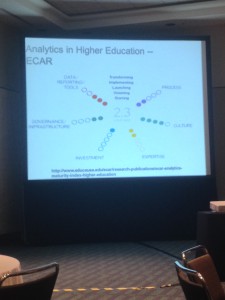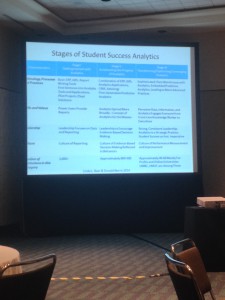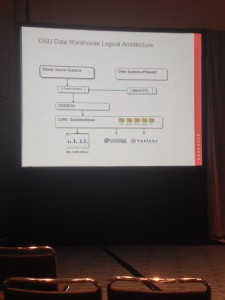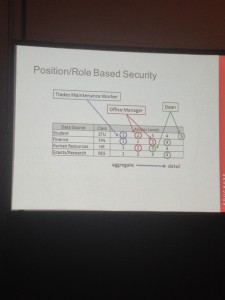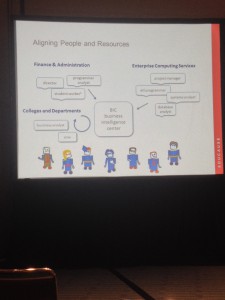Session 1; Building organisational capacity for learning analytics.
A fast paced expert panel session including Linda L Baer (without Don Norris) reporting on their 2013 white paper with the same title. Linda outlined the stages of development resource as well as the ECAR Analytics Maturity Index for Higher Education.
Next Ellen Wagner talked about PAR data sets, common framework and vocabularies. Importantly Linda outlined the Student Success Matrix; ‘knowing what to do next’ an analysis of actions institutions have taken and how effective they were. See data cookbook; http://www.par.datacookbook.com
University of Wisconsin described their journey of building organisational capacity for Learning Analytics;
1. Tech infrastructure, analytics tools and applications
2. Policies, processes, practices and workflows
3. Values and skills (includes learning analytics faculty support role)
4. Culture and behaviour
5. Leadership
Last Improving retention and advancement through the ‘education and career positioning’ system – Wisconsin. The suggestion here is to stop making things complicated. Students need to make informed decisions to achieve ‘advancement’ through education. Give students appropriate access to their data to help with this. This is personalising analytics – tailor it to the students. Comparison between travel self navigation vs education – career self navigation. The former is mature, the latter lacking.
KEY LEARNING: Predictions might lift the likelihood of identifying at risk students by 20%, 25%, 30%. This should be seen as a success. See the PAR Data Cookbook for actionable insights and the actions most successful in addressing them. Download the Baer and Norris 2013 white paper to help get started with Learning Analytics. This includes common data definitions and some practical tools which look well worth further exploration. UNISON is a consortium of American Universities working in collaboration to develop Learning Analytics in ways they have been unable to individually. Call for more pressure on IMS Global from US HE.
Session 2; BI Driven Social and Cultural Change
Session being streamed around the world. How exciting!
Michael Hanson Finance Director and Director of the BI Institute, Oregon State
Lois Brookes CIO Oregon State
and colleagues from George Washington University
BI initiative came from CIO in response to demand for data.
1995-2013
1. Data Warehouse from
2. Self Service Reporting
2010-12 failed implementation of a vendor BI solution – why – no SRO, technical challenges, user satisfaction levels, project cost escalated due to staffing, maintenance agreements and hardware. Terminated in April 2013 after 1.8 million dollar spend with little progress.
Restarted the BI initiative and have a fully successful service after 18 months. Here’s how;
Identified why the initiative was core to the university;
‘Data is a strategic asset if the university but only to the extent that it is available, true and actionable’
Used Agile development (iterative cycles) and have 300 plus reports with 1600 users by addressing Organisational and Technological issues
Automatic role based authorisation
Requires a Business Intelligence Competency Centre
KEY LEARNING Organisational; View data as a strategic asset. Make data a part of the strategic plan. Discover what the senior managers need and turn them into champions. Introduce the notion of Data Stewardship – to smooth the way to organisational acceptance. Communicate the project at every opportunity. Trust employees. Be responsive to demands (aim to iteratively produce analyses in 2-3 days).
Technological; Build a data architecture. Enforce a no modifications policy at local level. Use Open Source and existing licenses where possible. Role based security to cope with number of users.
Talend for ETL
Tableau for report development

